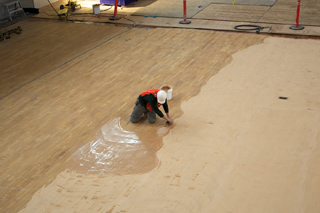|
Subscribe / Renew |
|
|
Contact Us |
|
| ► Subscribe to our Free Weekly Newsletter | |
| home | Welcome, sign in or click here to subscribe. | login |
Architecture & Engineering
| |
 Museum of History & Industry Museum of History & Industry |
January 7, 2013
Faced with a sloped floor, MOHAI crews rolled with it
Sellen Construction

Morris
|
From the beginning it was clear this was going to be a special project, not only because it was an opportunity to renovate a nationally registered historic building, but also because of the client. Creating a space for MOHAI, one of Seattle’s oldest historical societies, presented many unique challenges and opportunities.
In the armory, galleries were created from spaces originally used for a firing range, a ship’s bridge and submersion drills. Structural upgrades allowed the museum to hang one of Boeing’s first airplanes as well as one of Seattle’s iconic hydroplanes.
Sellen installed a glass elevator, accommodated a sculpture that spans from Lake Union through the roof, and squeezed every possible inch of ceiling height into the new gallery spaces. The team coordinated activities with Lake Union Park and the Center for Wooden Boats to ensure we were a good neighbor throughout.
Collaboration with the exhibit team began prior to demolition and continued until the museum’s opening. Detailed coordination was required for nearly every artifact, including lighting and dimming controls, exact locations for significant structural support, and placement of the hole in the floor for John Grade’s “Wawona” sculpture.
Many of the construction challenges were centered on achieving the major goals identified by MOHAI early in the project, such as meeting federal historic-building rehabilitation requirements and achieving the highest LEED rating possible.
A sloped floor
The most challenging characteristic of the building during construction was the 15-inch slope from the southwest corner to the northwest corner. We believe the building settled in its first 10 years of operation, causing the slope.
You could essentially drop a marble at the southwest corner and watch it roll out the back door in the northeast corner moments later. Leveling the building was not an option, so MOHAI, LMN Architects and Sellen had to roll with it — literally.
Designing and constructing a historic renovation with a 15-inch slope while also making the building appear level to visitors is easier said than done. The disparity affected almost everything and required extensive coordination amongst the project team.
We scanned the building using a high-definition laser to aid in the development of a detailed 3-D model. Working closely with the architect and subcontractors, the model provided our team with a platform to craft constructible solutions with confidence.
The solutions varied and almost every element had to be considered independently. The majority of architectural elements, such as the mirrors, were installed parallel to the floor, ceiling and windows, all of which sloped. In contrast, many construction systems — including the mechanical piping, doors, and chilled water system — were installed level with no slope.
The end result is almost an optical illusion. Each door in the building is horizontally level with the floors and ceilings, however the doors in the northeast end sit 15 inches lower than those in the southwest corner.
Keeping out the rain
The 12,500-square-foot drill hall floor of the armory is composed of end grain wood from its original construction, and was a historic element we needed to maintain. In a standard renovation this would not have been a major challenge.
However, the ceiling structures that covered the second level had to be raised. This required demolition of the original concrete structure and installation of a new steel structure, leaving the floor fully exposed in the middle of one of Seattle’s wettest winters.
Our team installed a water barrier and temporary storage containers on the second level to divert the first onslaught of rainfall. A second barrier was placed on the first level, effectively capturing all water before it reached the floor. The enclosures drained to collection areas, which we pumped daily.
Our efforts paid off and no water reached the floor despite approximately 16 inches of rainfall. Preserving the wood floor was required for historic preservation and it also contributed LEED points to the project.
LEED platinum
Our team was originally targeting a LEED gold rating, but in the summer of 2012 — midway through construction — MOHAI challenged us to achieve LEED platinum. We worked closely with the design team to develop strategies to obtain LEED platinum without increasing the budget.
In one instance, we identified that one vendor’s key product selection and purchasing strategy was critical to achieving six additional LEED points. MOHAI and Sellen worked with the vendor to ensure that only LEED-compliant products were sourced, and our points were secured.
Our team obtained additional LEED credits without adding cost by focusing on our construction waste-management program. The team achieved a waste-diversion rate of more than 97 percent, recycled and salvaged more than 1,538 tons of material, and also salvaged 1,646 lineal feet of historical wood base.
Working in water
While the building appears to sit on land, it actually sits on “stilts” directly over Lake Union. As part of the structural upgrades and elevator installations, we had to work under the building, which meant working in the water.
Sellen iron workers, laborers and carpenters, as well as subcontractors, donned chest and hip waders to work in the cold temperatures of Lake Union. To reach the water and build in the necessary spaces, we cut holes through the concrete floor and built special devices to prevent debris from falling into the lake. We also constructed a containment barrier around the perimeter of the building as a secondary precaution. These efforts, and other stormwater control measures, also helped us achieve LEED platinum.
Our portion of the project finished last April on schedule and within the anticipated budget. In December, the U.S. Green Building Council awarded it a LEED platinum rating, meeting MOHAI’s goal.
With a history that dates farther back than the armory itself, it’s fitting that MOHAI now has a new home with its own history to add to the museum’s story.
Mike Morris is a senior vice president and senior project manager at Sellen Construction. He has been with Sellen for more than 20 years and has worked with many of the region’s arts organizations.
Other Stories:
- MOHAI's unique exhibits deliver surprising facts in surprising ways
- Making a new home for history on Lake Union
- A history museum that also shows our present and future



